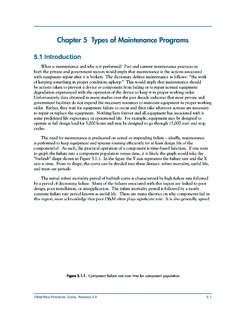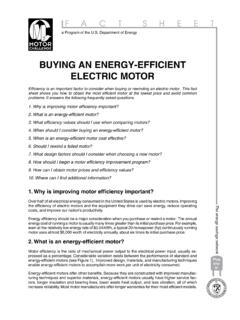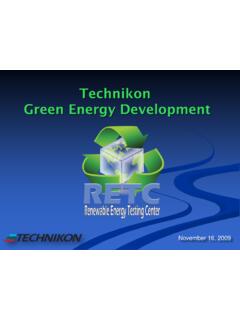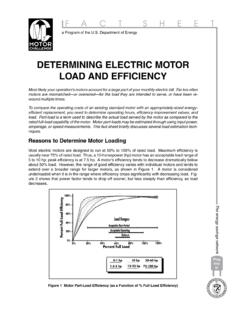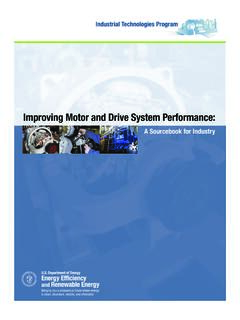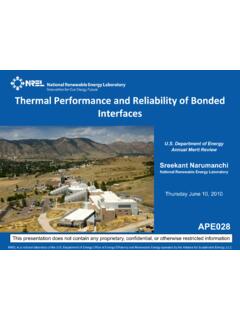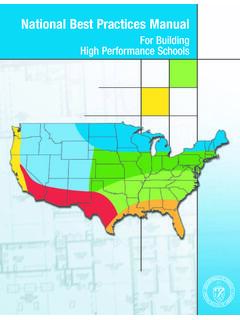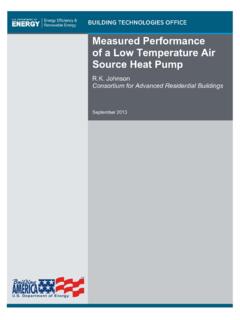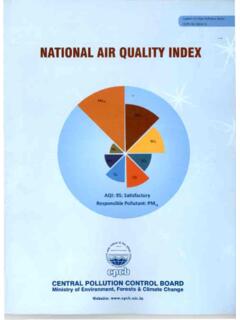Transcription of Chapter 3 O&M Management - Energy
1 O&M Best Practices Guide, Release Chapter 3 O&M Management Introduction O&M Management is a critical component of the overall program. The Management function should bind the distinct parts of the program into a cohesive entity. From our experience, the overall program should contain five very distinct functions making up the organization: Operations, Maintenance, Engineering, Training, and Administration OMETA. Beyond establishing and facilitating the OMETA links, O&M managers have the responsibility of interfacing with other department managers and making their case for ever-shrinking budgets. Their roles also include project implementation functions as well as the need to maintain persistence of the program and its goals. Developing the Structure Five well-defined elements of an effective O&M program include those presented above in the OMETA concept (Meador 1995).
2 While these elements, Operations, Maintenance, Engineering, Training, and Administration, form the basis for a solid O&M organization, the key lies in the well-defined functions each brings and the linkages between organizations. A subset of the roles and responsibilities for each of the elements is presented below; further information is found in Meador (1995). Operations Administration To ensure effective implementation and control of operation activities. Conduct of Operations To ensure efficient, safe, and reliable process operations. Equipment Status Control To be cognizant of status of all equipment. Operator Knowledge and Performance To ensure that operator knowledge and performance will support safe and reliable plant operation. Maintenance Administration To ensure effective implementation and control of maintenance activities.
3 Work Control System To control the performance of maintenance in an efficient and safe manner such that economical, safe, and reliable plant operation is optimized. Conduct of Maintenance To conduct maintenance in a safe and efficient manner. Preventive Maintenance To contribute to optimum performance and reliability of plant systems and equipment. OPERATIONS ENGINEERING ADMINISTRATION TRAINING MAINTENANCE O&M INTEGRATION O&M Management Maintenance Procedures and Documentation To provide directions, when appropriate, for the performance of work and to ensure that maintenance is performed safely and efficiently. Engineering Support Engineering Support Organization and Administration To ensure effective implementation and control of technical support. Equipment Modifications To ensure proper design, review, control, implementation, and documentation of equipment design changes in a timely manner.
4 Equipment Performance Monitoring To perform monitoring activities that optimize equipment reliability and efficiency. Engineering Support Procedures and Documentation To ensure that engineer support procedures and documents provide appropriate direction and that they support the efficiency and safe operations of the equipment. Training Administration To ensure effective implementation and control of training activities. General Employee Training To ensure that plant personnel have a basic understanding of their responsibilities and safe work practices and have the knowledge and practical abilities necessary to operate the plant safely and reliably. Training Facilities and Equipment To ensure the training facilities, equipment, and materials effectively support training activities. Operator Training To develop and improve the knowledge and skills necessary to perform assigned job functions.
5 Maintenance Training To develop and improve the knowledge and skills necessary to perform assigned job functions. Administration Organization and Administration To establish and ensure effective implementation of policies and the planning and control of equipment activities. Management Objectives To formulate and utilize formal Management objectives to improve equipment performance. Management Assessment To monitor and assess station activities to improve all aspects of equipment performance. Personnel Planning and Qualification To ensure that positions are filled with highly qualified individuals. Industrial Safety To achieve a high degree of personnel and public safety. O&M Best Practices Guide, Release O&M Management Obtain Management Support Federal O&M managers need to obtain full support from their Management structure in order to carry out an effective Management reports should not maintenance program.
6 A good way to start is by establishing assign blame for poor maintenance a written maintenance plan and obtaining upper Management and inefficient systems, but rather approval. Such a Management -supported program is very to motivate efficiency improvement through improved because it allows necessary activities to be sched-uled with the same priority as other Management actions. Approaching O&M by equating it with increased productivity, Energy efficiency, safety, and customer satisfaction is one way to gain Management attention and support. When designing Management reports, the critical metrics used by each system should be compared to a base period. For example, compare monthly Energy use against the same month for the prior year, or against the same month in a particular base year (for example, 1985).
7 If efficiency standards for a particular system are available, compare your system s performance against that standard as well. Management reports should not assign blame for poor maintenance and inefficient systems, but rather to motivate efficiency improvement through improved maintenance. The O&M Mission Statement Another useful approach in soliciting Management buy-in and support is the development an O&M mission statement. The mission statement does not have to be elaborate or detailed. The main objective is to align the program goals with those of site Management and to seek approval, recognition, and continued support. Typical mission statements set out to answer critical questions a sample is provided below: Who are we as an organization specifically, the internal relationship? Whom do we serve specifically, who are the customers?
8 What do we do specifically, what activities make up day-to-day actions? How do we do it specifically, what are the beliefs and values by which we operate? Finally, how do we measure success what metrics do we use, ( , Energy /water efficiency, safety, dollar savings, ) A critical element in mission statement development is involvement of upper Management and facility staff alike. Once involved with the development, there will be ownership which can lead to compliance (facility staff) and support ( Management ). O&M Best Practices Guide, Release O&M Management Measuring the Quality of Your O&M Program Traditional thinking in the O&M field focused on a single metric, reliability, for program evaluation. Every O&M manager wants a reliable facility; however, this metric alone is not enough to evaluate or build a successful O&M program.
9 Beyond reliability, O&M managers need to be responsible for controlling costs, evaluating and implementing new technologies, tracking and reporting on health and safety issues, and expanding their program. To support these activities, the O&M manager must be aware of the various indicators that can be used to measure the quality or effectiveness of the O&M program. Not only are these metrics useful in assessing effectiveness, but also useful in cost justification of equipment purchases, program modifications, and staff hiring. Below are a number of metrics that can be used to evaluate an O&M program. Not all of these metrics can be used in all situations; however, a program should use of as many metrics as possible to better define deficiencies and, most importantly, publicize successes. Capacity factor Relates actual plant or equipment operation to the full-capacity operation of the plant or equipment.
10 This is a measure of actual operation compared to full-utilization operation. Work orders generated/closed out Tracking of work orders generated and completed (closed out) over time allows the manager to better understand workloads and better schedule staff. Backlog of corrective maintenance An indicator of workload issues and effectiveness of preventive/predictive maintenance programs. Safety record Commonly tracked either by number of loss-of-time incidents or total number of reportable incidents. Useful in getting an overall safety picture. Energy use A key indicator of equipment performance, level of efficiency achieved, and possible degradation. Inventory control An accurate accounting of spare parts can be an important element in controlling costs. A monthly reconciliation of inventory on the books and on the shelves can provide a good measure of your cost control practices.

